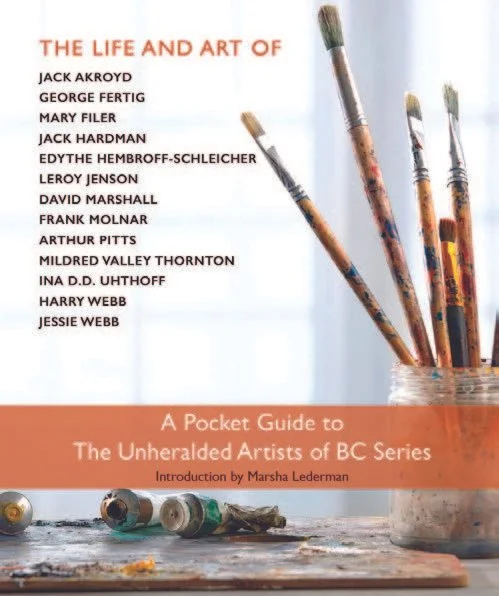A Pocket Guide to the Unheralded Artists of BC Series
Edited by Mona Fertig
Introduction by Marsha Lederman
Mother Tongue Publishing, 2020; 200 pages; $24.95
Reviewed by Trevor Carolan
In the late 1970s, poet Mona Fertig and a handful of young feminist writers shook up the boys’ club of Vancouver literary life. The Literary Storefront, Fertig’s broadly-inclusive Gastown writers’ centre brought innovations that made the book scene more diverse, democratic, and practical. No surprise that on becoming a publisher, Fertig — whose father George was an accomplished if neglected painter — would use books to rethink the canon of BC visual art.
Rectification is a term we last heard regularly during Mao Zedong’s Cultural Revolution in China. The lessons are obvious: making society better requires balance. outraging the bourgeoisie worked for Baudelaire and the fin-de-siècle Symbolists, but it’s a sketchy gambit nowadays when almost anything goes. Changing the way we think about art, notably about what qualifies, takes finesse. That led Fertig to produce a series of ten excellent books profiling the life and work of thirteen BC artists who, while mature and in it for the long grind, achieved little critical or commercial grace and favour. This absorbing new pocket guide condenses those editions with élan. It will leave you thinking about who makes the decisions in the art game, and why.
The “unheralded” artists worked here from the late 1930s onward, tapering off with age by the early 2000s. occupying a parallel stream of achievement to the golden, post-Emily Carr group of Jack Shadbolt, Gordon Smith, Toni Onley, BC binning, and associates, they received a mere fraction of the acclaim extended to the big names in town. Importantly, however, they shaped the bones of a no less gifted artistic community.
Their work hung in places like the small Danish art gallery on West Tenth that was there for ages, the Winchester in Oak Bay, or those little places on Kingsway that survived on a wing and a prayer. You’d view them at libraries, bookstore events, or during museum visits on family holidays in the Okanagan, the Kootenays, Vancouver Island. No longer unremembered, their names are instructive: Jack Ackroyd, Mary Filer, Jack Hardman, Mildred Valley Thornton, Edythe Hembroff-Schleicher, Leroy Jensen, David Marshall, Frank Molnar, Ina D.D. Unthoff, Harry Webb, Jesse Webb, Arthur Pitts, George Fertig. For the unfamiliar, this compact guide provides a lens into their biographies, the influences on their styles, and it explains how they cobbled together a living even as acclaim escaped them repeatedly. A gallery of vivid colour images depicts their capabilities — reflecting industrial labour, early encounters with Indigenous peoples and cultures, multicultural portraiture, productions in glass, concrete, stone, allegorical murals, hyperrealism. Many of the works are of stunning sophistication. Why were they ignored by art-world influencers?
The unheralded series attracted support from first-calibre contributors, so expect condensed versions of essays on the artists by Eve Lazarus, Sherrill Grace, Daniel Francis, Monica Ullmann, Max Wyman, Charles Van Sandwyck, and others. What emerges from their painstaking research and conversations with those who knew the artists, is a penetrating index of artist names, associations, exhibitions, and a record of dramatic emotional breakdowns with an insufficiency of gallery triumphs. The overall result is a look into the deeper structure of events in BC art history reaching back to the glory days of Emily Carr.
Edythe Hembroff-Schleicher wrote on her mentor Carr and painted works of dazzling virtuosity herself. Harry Webb, an illustrator and landscape consultant co-founded the historic Cellar jazz club. Mildred Valley Thornton painted portraits of Indigenous Elders that are now collected by the Squamish Nation for their own archival history. As director of the Burnaby Art Gallery, Jack Hardman sponsored shows by outrider artists who couldn’t raise a smile at the VAG. George Fertig exchanged correspondence with Carl Jung but was ignored as a visionary painter. Sculptor David Marshall could find recognition in the US, but rarely in his hometown. Why, the question arises repeatedly, did these BC figures not receive their critical due?
This pocket guide is tremendously readable. A searching work, it makes clear that a major VAG exhibit — one that delves deeply into the kinds of art, from a broader tapestry of artists than we’ve been seeing there for a long time — is deeply overdue. Reading this pocket Guide, and indeed the larger unheralded Artists of BC series is the logical first step toward that redress. I wouldn’t miss a rectifying show at the VAG like that for all the tea in China.

